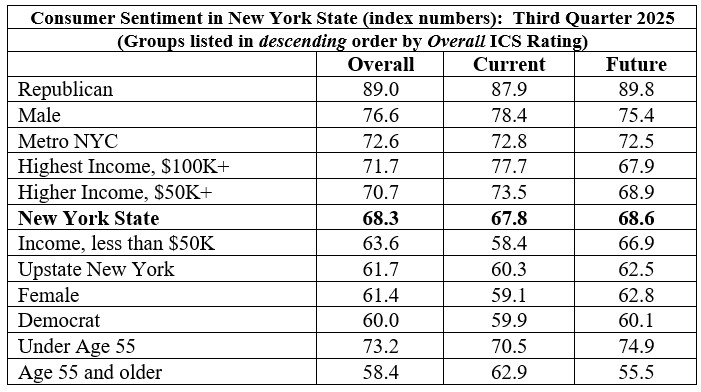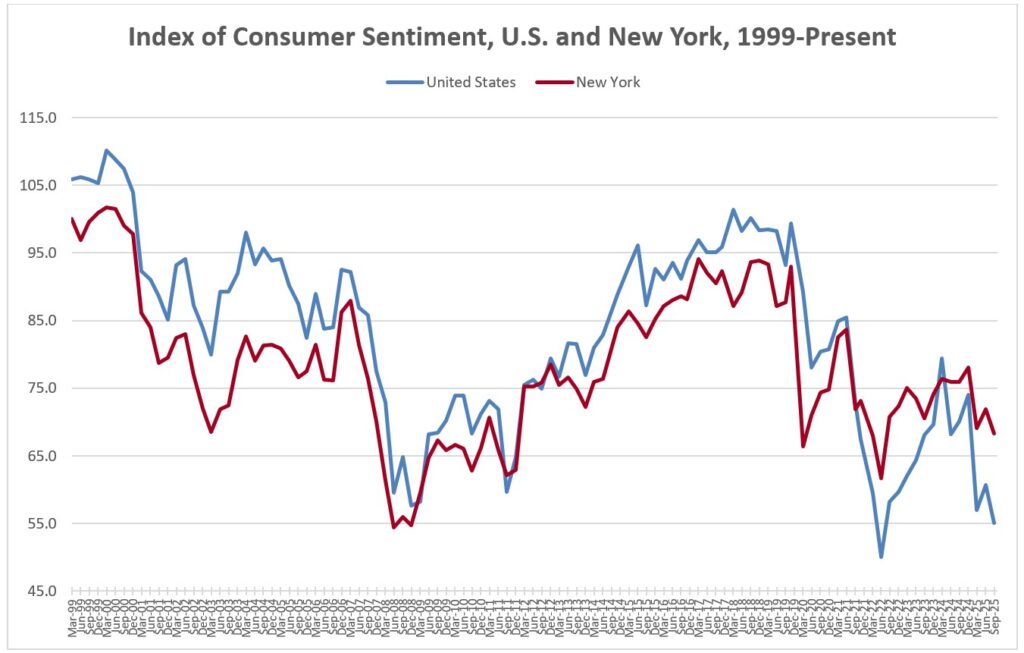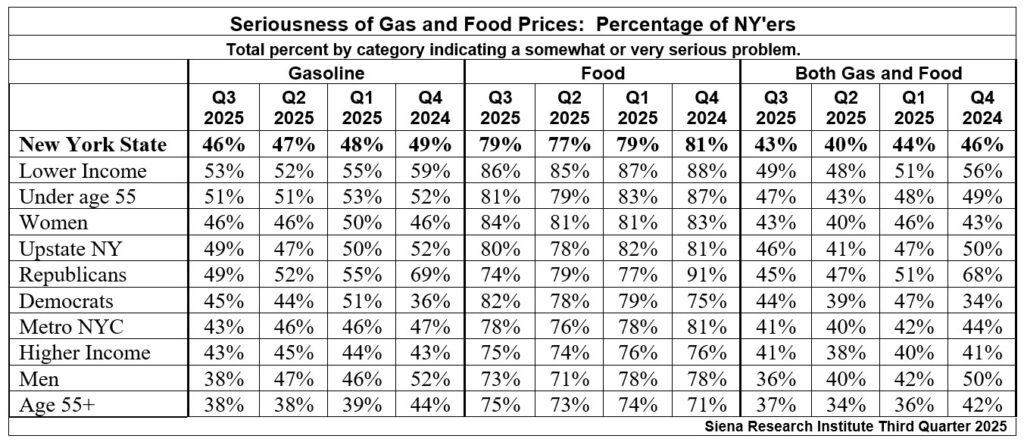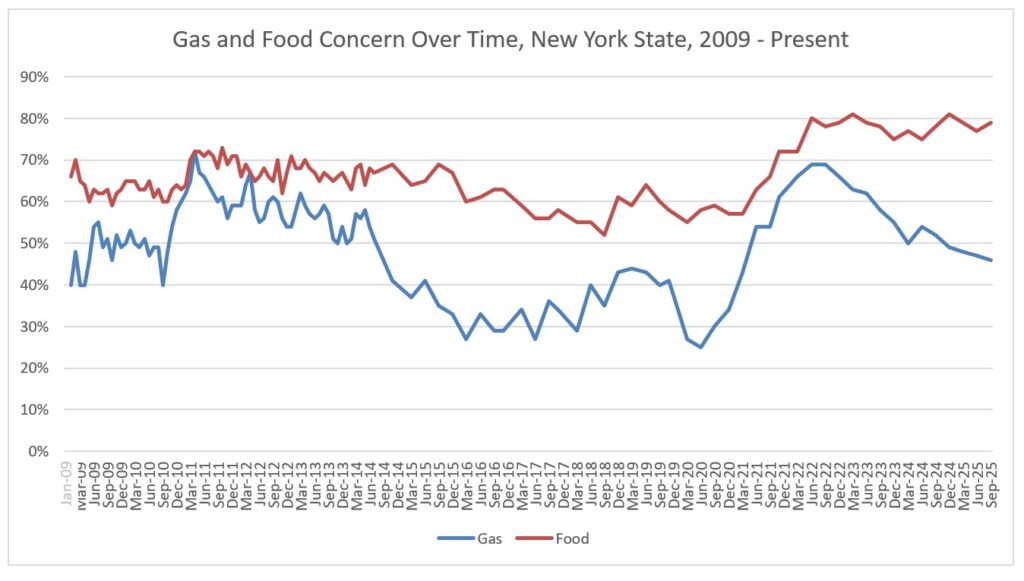- Partisan Divide Widens: 29-Point Gap Between NY Democrats and Republicans on Economy; GOP Confidence Remains High, Democrats at 5-Year Low
- Buying Plans Weaken; 79% of New Yorkers Say Food Prices Seriously Impact Finances, 46% Say the Same for Gas
Press Release Summary Trends Buying Plans Gas and Food
Loudonville, NY – The New York State Index of Consumer Sentiment now stands at 68.3 down 3.6 points from the last measurement in the second quarter of 2025 according to the latest poll by the Siena Research Institute (SRI). New York’s overall Index of Consumer Sentiment is 13.2 points above the national* index of 55.1 following a 5.6-point national decrease. New York’s current index fell 3.8 points to 67.8 and New York’s measure of future expectations decreased 3.4 points from 72.0 last quarter to 68.6 today. The Index of Consumer Sentiment remains higher in New York than across the nation. For the third consecutive quarter, the overall index is below the breakeven point of balanced optimism and pessimism.

“Like the autumn leaves, consumer sentiment is falling across New York and the nation as persistent economic headwinds have consumers feeling the pressure coming out of the summer season. In all quarterly measurements taken during 2025, consumer sentiment in both New York and across the nation has failed to rise above the breakeven point where optimism exceeds pessimism. While both New York and the nation saw current sentiment fall by four points, New York’s future outlook held much steadier, dropping by nearly four points compared to a significant national decline of over six points,” according to Travis Brodbeck, SRI’s Associate Director of Data Management. “New York Democrats report their bleakest economic outlook in five years, with overall sentiment dropping to 60. New York Republicans, by contrast, continue to show far greater optimism about the economy, with overall sentiment at 89. The Index of Consumer Sentiment in New York—and nationally—is now at its lowest point since 2022.”
Buying plans in the third quarter are mostly negative. Since the previous quarter’s measurement, buying plans for cars or trucks increased 1.8% (from 17.8%) to 19.6%. The two largest decreases in buying plans were in consumer electronics, falling 2.8% to 44.2%, and homes, dropping to 8.7% (from 10.9%). Major home improvement plans edged down to 23.3% (from 23.6%) and buying plans for furniture fell slightly to 29.7% from 30.2%, a 0.5% decrease. Forty-six percent (1% decrease from last quarter and the lowest since March 2021) of all New Yorkers say that current gasoline prices are having a very serious or somewhat serious impact on their financial condition. Seventy-nine percent (up from 77% last quarter) of state residents indicate that the amount of money they spend on groceries is having either a very serious or somewhat serious impact on their finances.
“When it comes to making major purchases, consumers pulled back modestly this quarter, but they continue to spend,” Brodbeck said. “Gasoline and food prices remain a serious strain on New Yorkers’ finances, yet residents are not signaling any major belt-tightening. Most buying plans are down—with the exception of cars and trucks—but over the past five years, intent to spend has remained relatively stable. While questions about tariffs linger, residents continue to endure higher prices that have a serious impact on their budgets.”
New Yorkers continue to feel the weight of essential monthly expenses. This quarter, 71% say housing costs are having a serious impact on their financial situation, down slightly from 72% last quarter. Utility costs are at 72% (up from 66% last quarter), and 50% say streaming and entertainment services are a financial strain (down from 53% last quarter). Reports of cell phone costs being a very or somewhat serious financial burden remained steady at 38%. Nearly six in ten, 56%, of New Yorkers say they are seriously impacted by all three essentials—housing, utilities, and food. Nineteen percent of residents report that all six key monthly expenses—food, gas, housing, utilities, entertainment, and cell phones—are weighing heavily on their finances.
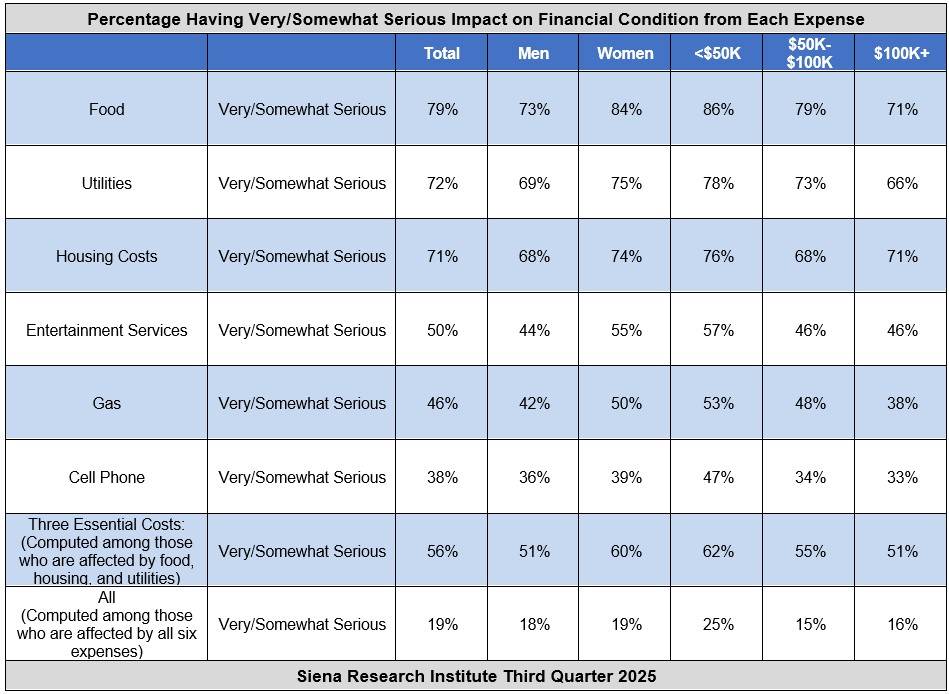
This Siena Poll was conducted September 15 – 22, 2025, among 814 New York State Residents. Of the 814 respondents, 392 were contacted through a dual frame (landline and cell phone) mode (117 completed via text to web) and 422 respondents were drawn from a proprietary online panel (Cint). Telephone calls were conducted in English and respondent sampling was initiated by asking for the youngest person in the household. Telephone sampling was conducted via a stratified dual frame probability sample of landline and cell phone telephone numbers weighted to reflect known population patterns. The landline telephone sample was obtained from ASDE and the cell phone sample was obtained from Marketing Systems Group (MSG). Interviews conducted online are excluded from the sample and final analysis if they fail any data quality attention check question. Duplicate responses are identified by their response ID and removed from the sample. Three questions were asked of online respondents, including a honey-pot question to catch bots and two questions that ask respondents to follow explicit directions. The proprietary panel also incorporates measures that safeguard against automated bot attacks, deduplication issues, fraudulent VPN usage, and suspicious IP addresses. Coding of open-ended responses was done by a single human coder. Data from collection modes was weighted to balance sample demographics to match estimates for New York State’s population using data from the Census Bureau’s 2023 U.S. American Community Survey (ACS), on age, region, race/ethnicity, and gender to ensure representativeness. The sample was also weighted to match current patterns of party registration using data from the New York State Board of Elections. It has an overall margin of error of +/- 3.7 percentage points including the design effects resulting from weighting. Sampling error is only one of many potential sources of error and there may be other unmeasured error in this or any other public opinion poll. The Siena Research Institute, directed by Donald Levy, Ph.D., conducts political, economic, social, and cultural research primarily in NYS. SRI, an independent, non-partisan research institute, subscribes to the American Association of Public Opinion Research Code of Professional Ethics and Practices. For survey cross-tabs: www.Siena.edu/SRI/.
Appendices
